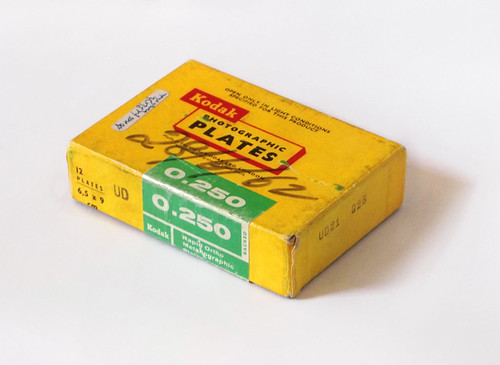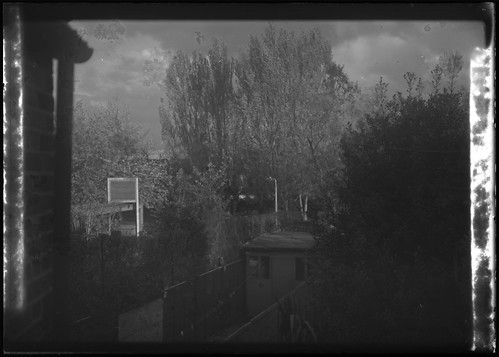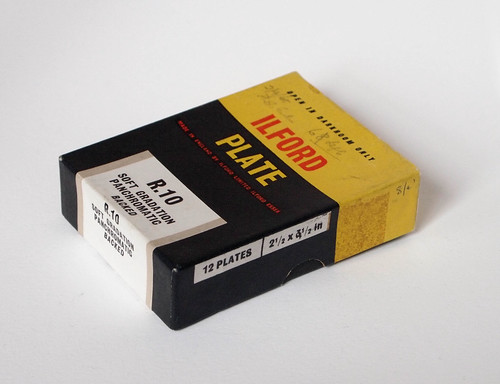 |
| Ilford R.10 Soft Gradation Panchromatic Glass Plates |
The first old films I had developed, or used and developed, I'd come across by accident, usually finding them in or with cameras I'd bought, found or been given. Having achieved results of varying success, I began to seek out expired films on occasion, when able to find them cheaply, and this then extended to glass plates. I have a few cameras which take plate holders, which I had previously used with film or
paper.
Having accumulated a few boxes of glass plates, recent sunny weather provided me with the excuse to try some. A couple of the boxes had already been opened, and it made sense to use plates from one of these first. I chose
Ilford R.10 Soft Gradation Panchromatic plates, which I'd bought in a lot with a box of unopened FP4 plates, not knowing whether the plates in the open box had been exposed to light or not. Both boxes have writing in pencil with the date 2/9/65 and 'Photo Centre'; the box of R.10 has "6 8 [crossed out] left". According to the Ilford chronology on the
Photomemorabilia website, glass plate production by Ilford finished in 1975 (Ilford do still make photographic glass plates for specialised applications in the nuclear and particle physics industry; some other manufacturers still make plates for general photography, but these are very expensive and a number of photographers coat their own glass plates).
The box originally held 12 plates, 2 1/2x3 1/2 inch size. There are
a number of standard plate sizes, both metric and imperial, and a confusion sometimes arises between the closeness of the different sizes: metric and imperial standards are sometimes treated as being interchangeable. There is a metric 6.5x9cm plate size, which is very close to the 2 1/2x3 1/2 imperial size (being 6.4x8.9cm; I have a box of 6.5x9cm plates which has a handwritten label "Do not fit 3 1/2x2 1/2 single slides"). I used 6.5x9cm plate holders, which the imperial size plates will fit, while metric plates of that size wouldn't fit into similarly sized imperial holders.
The camera I shot the plates in is an
Ica Icarette L, a dual format camera from the 1920s that takes either 120 film, or 6.5x9cm plates. When I bought this, it came with a plate holder wallet containing four single plate holders, and the following leaflet:-
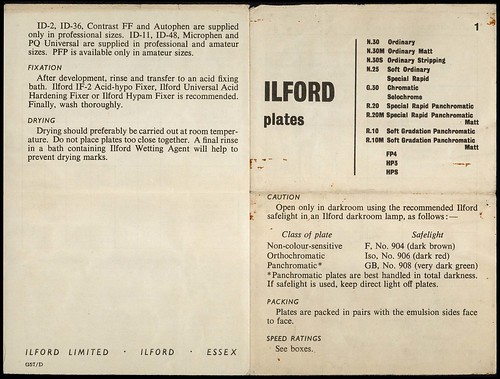 |
| Ilford Plates leaflet - outside |
 |
| Ilford Plates leaflet - inside |
There's a code on the back of the leaflet, 'G57/D' - possibly referring to its date i.e. 1957. Under 'Packing' it explicitly states that "plates are packed in pairs with the emulsion sides face to face," something I had previously read on a forum, which was good to have confirmed. The pairs of plates are wrapped in black paper, with a thin paper 'runner' holding these together along the short edges. The glass is very thin, less than 2mm and the cut edges of the glass are still sharp.
The R.10 plates were originally rated 100 ISO (the label around the box gives 'Meter settings for minimum exposure ASA 100 DIN 21'). With my previous experience of using out of date film (see the posts about
Verichrome and
127 Day), and knowing that the sensitivity would have decreased with time, I shot two plates, the first at 25 ISO, and a second at 12. Exposure was 1/50th at f5.6 and f4.5 respectively. I stand developed the plates in a Combi Plan tank using Rodinal diluted 1:100 for one hour, with 2 minutes pre-soak, and 3 inversions at the half hour mark. The first plate came out black - this one would have been at the top of the box, possibly this had been exposed to light with the box opened at some point, although I'm not ruling out making an error myself. The second plate has a small amount fogging at the left and bottom sides. Once fixed and washed I did not squeegee the plates, but even so the plates took a long time to dry. (Incidentally, I've been reading Ansel Adams' The Negative recently, and in a section on water bath development, Adams compares older thick emulsions favourably to modern thin ones, perhaps the emulsion on the R.10 plates is thicker, and so absorbs more water). The second plate came out well:-
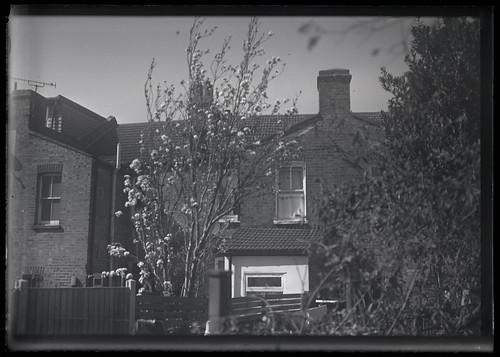 |
| Ilford R.10 glass plate, shot with Ica Icarette L |
Aspects of framing and focus of the plate not withstanding, there is something precious and unique about holding a glass negative in one's hand: there's probably a longer essay to be written about how the ease of taking thousands of digital images, compared to dozens on a roll of film, or single sheets, plates and Polaroids, has devalued the photographic image; it may be something to do with the physicality of the image and its physical link (perhaps misconstrued) to authenticity.
Edit: 29/04/13
As a result of my research into Ilford, I discovered the
Ilford Technical Information Book, which contains a sheet on the R.10 Soft Gradation Panchromatic plates, dated to 1967. This provides additional information for the plates from the leaflet shown above. It gives the ASA setting for tungsten lighting as 64, against the daylight setting of 100. The table of development times gives further dilutions and times for both continuous and intermittent agitation.
 |
| Ilford R.10 development times |
 |
| Ilford R.10 Curves |








